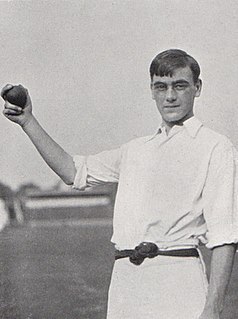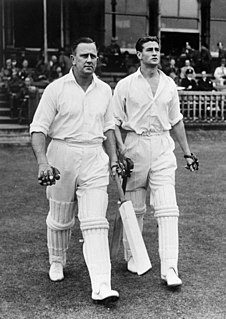Related Research Articles

Sir Leonard Hutton was an English cricketer. He played as an opening batsman for Yorkshire County Cricket Club from 1934 to 1955 and for England in 79 Test matches between 1937 and 1955. Wisden Cricketers' Almanack described him as "one of the greatest batsmen in the history of cricket". He set a record in 1938 for the highest individual innings in a Test match in only his sixth Test appearance, scoring 364 runs against Australia, a milestone that stood for nearly 20 years. Following the Second World War, he was the mainstay of England's batting. In 1952, he became the first professional cricketer of the 20th century to captain England in Tests; under his captaincy England won the Ashes the following year for the first time in 19 years.

John Neville Crawford was an English first-class cricketer who played mainly for Surrey County Cricket Club and South Australia. An amateur, he played as an all-rounder. As a right-handed batsman, Crawford had a reputation for scoring quickly and hitting powerful shots. He bowled medium-paced off spin and was noted for his accuracy and his ability to make the ball turn sharply from the pitch. Unusually for a first-class cricketer, Crawford wore spectacles while playing.

Martin Paterson Donnelly was a New Zealand-born sportsman who played Test cricket for New Zealand and rugby union for England. He worked for Courtaulds in England and Sydney.

Alan Melville was a South African cricketer who played in 11 Tests from 1938 to 1949. He was born in Carnarvon, Northern Cape, South Africa and died at Sabie, Transvaal.

Frederick Theodore Badcock was a New Zealand first-class and Test cricketer. Perhaps the best all-rounder in New Zealand in the inter-war period, he played seven Test matches for New Zealand between 1930 and 1933, including New Zealand's inaugural Test in 1930. He was the first players capped by New Zealand.

Douglas Thomas Ring was an Australian cricketer who played for Victoria and for Australia in 13 Test matches between 1948 and 1953. In 129 first-class cricket matches, he took 426 wickets bowling leg spin, and he had a top score of 145 runs, which was the only century of his career.
Richard Pollard was an English cricketer born in Westhoughton, Lancashire, who played in four Test matches between 1946 and 1948. A fast-medium right-arm bowler and a lower-order right-handed batsman who made useful runs on occasion, he played for Lancashire between 1933 and 1950, taking 1,122 wickets in 298 first-class matches; he is 10th highest wicket-taker for Lancashire.

William Gilbert Anthony Parkhouse was a Welsh cricketer who played in seven Tests for England in 1950, 1950–51 and 1959.

George Nathaniel Francis was a West Indian cricketer who played in West Indies' first Test in their inaugural Test tour of England. He was a fast bowler of renowned pace and was notably successful on West Indies' non-Test playing tour of England in 1923, but he was probably past his peak by the time the West Indies were elevated to Test status. He was born in Trents, St. James, Barbados and died at Black Rock, Saint Michael, also in Barbados.

John Cowie was a New Zealand cricketer who played in nine Tests from 1937 to 1949. His Test opportunities were restricted by New Zealand's limited programme, and his cricket career was interrupted by World War II from 1939 to 1945. Following the 1937 tour of England, Wisden commented: "Had he been an Australian, he might have been termed a wonder of the age."
The 1938 Ashes series between Australia and England was drawn. England and Australia won a Test each, with two of the other Tests drawn and the third game of the series, scheduled for Manchester, abandoned without a ball being bowled, only the second instance of this in more than 60 years of Test cricket. The Australians retained The Ashes.

The Indian cricket team toured England in the 1932 season under the title of "All-India". They were captained by the Maharaja of Porbandar. It was the national team's second tour of England following the one in 1911. India had just been granted the status of ICC Full Member and they played their inaugural Test match at Lord's in June. It was the only Test arranged on this tour and England won by 158 runs after scoring 259 and 275/8d in the two innings while India were bowled out for 189 and 187.
The New Zealand cricket team toured England in the 1937 season. The team was the third from New Zealand to tour England, following those of 1927 and 1931, and the second to play Test matches. Three Tests were arranged: England won the second match at Manchester, and the games at Lord's and The Oval were drawn, the latter affected by rain. On the tour as a whole, the New Zealanders played 32 first-class matches, winning nine and losing nine, with 14 ending as draws.
The New Zealand cricket team toured England in the 1949 season. The team was the fourth official touring side from New Zealand, following those in 1927, 1931 and 1937, and was by some distance the most successful to this date. The four-match Test series with England was shared, every game ending as a draw, and of 35 first-class fixtures, 14 were won, 20 drawn and only one lost.
The tour by the English cricket team in South Africa in 1909–10 was organised by Marylebone Cricket Club (MCC). The team played as MCC in the non-Test fixtures and as England in the five Test matches. They played 14 first-class matches including the Tests, winning 7 times with 3 draws and 4 defeats.

Cecil George Pepper was an Australian first-class cricketer who became a professional in English league cricket and later a first-class umpire in England. An allrounder, he was the first to complete the double twice in the Central Lancashire League. He once scored 38 runs off an eight-ball over.
T. N. Pearce's XI was a scratch cricket team composed largely of Test and other prominent first-class players.
With the end of the Second World War's European theatre in early May, it was possible to organise eleven first-class cricket matches, the first to be played in England since 1939, though none were part of any official competition.
William Territt Greswell was an English first-class cricketer who played for Somerset from 1908 to 1930. But his career as a tea-planter with the family company in Sri Lanka meant that he appeared in only 115 first-class matches for the county in that period, and was a regular player in only five seasons, dotted over almost 20 years.
Reginald Trevor Crawford was an English cricketer who played as a right-handed batsman and a right-arm fast-medium bowler in first-class cricket between 1901 and 1911. He played mainly for Leicestershire from 1901 to 1907, returning for a single match in both 1910 and 1911, and also played for amateur teams. He was born in Leicester and died at Swiss Cottage, London. He was the brother of the England Test cricketer Jack Crawford and of the Surrey and Leicestershire first-class cricketer Vivian Crawford.
References
- ↑ "HDG Leveson-Gower's XI v New Zealand Services 1945". Cricinfo. Retrieved 27 December 2019.